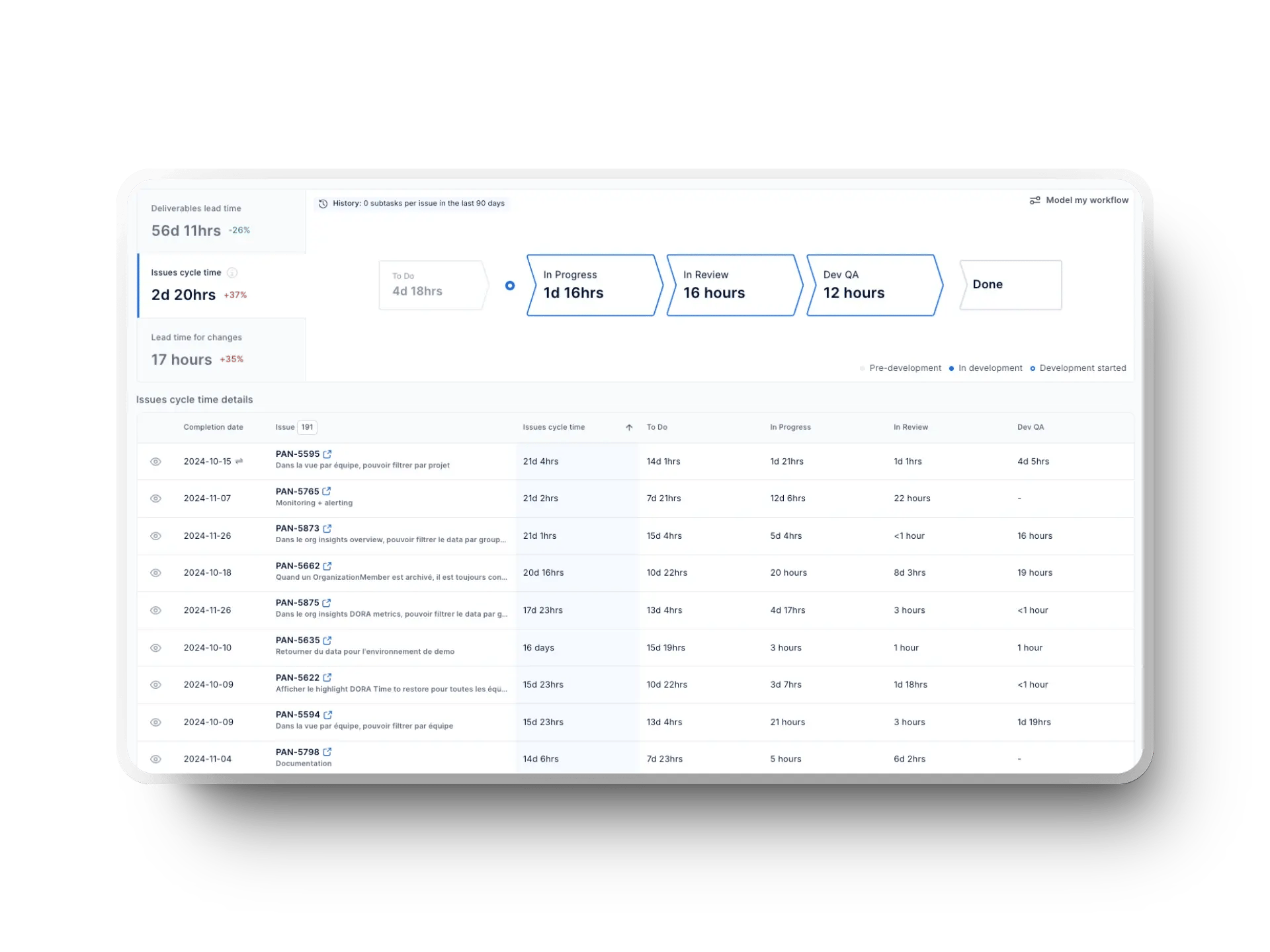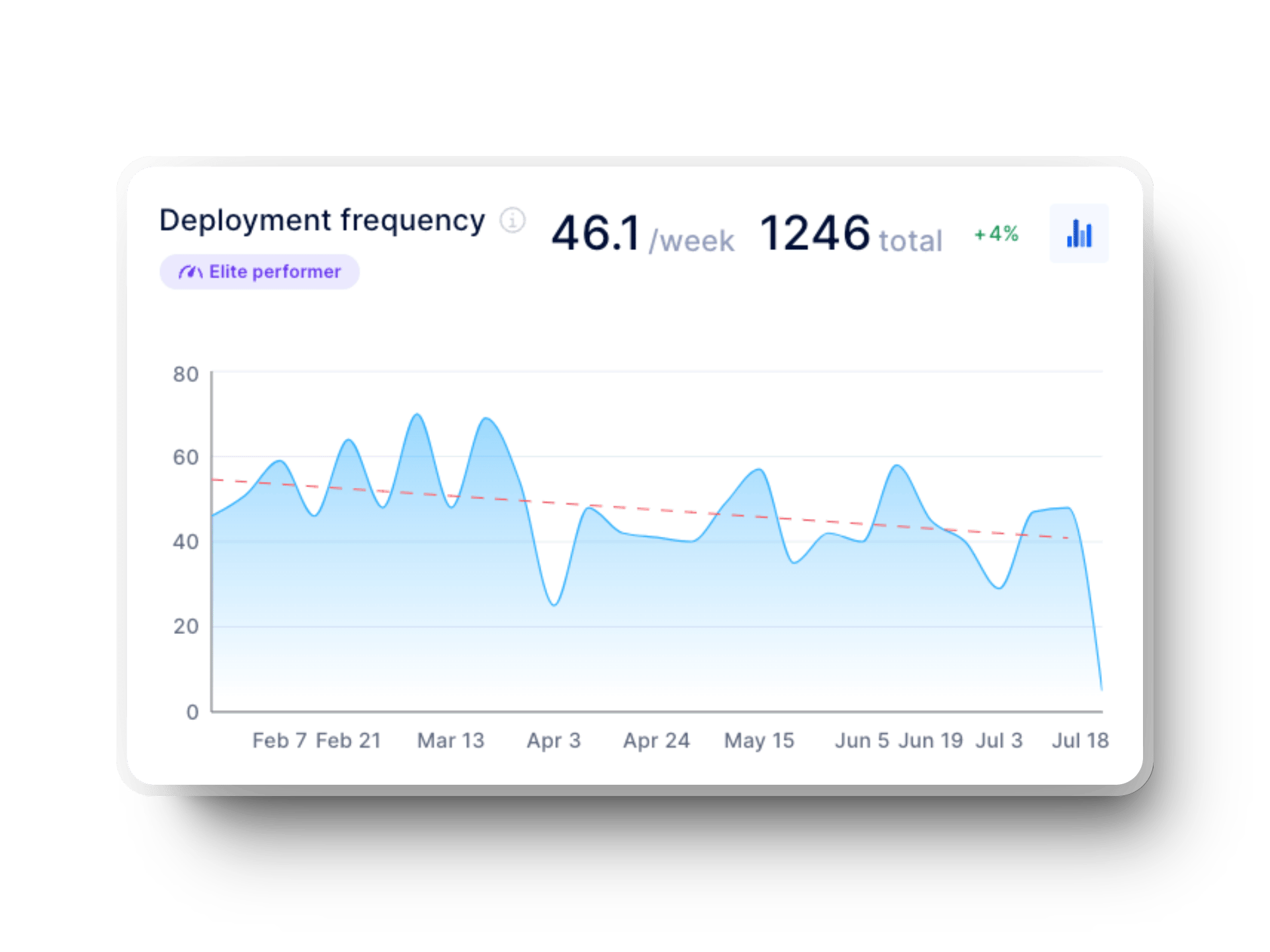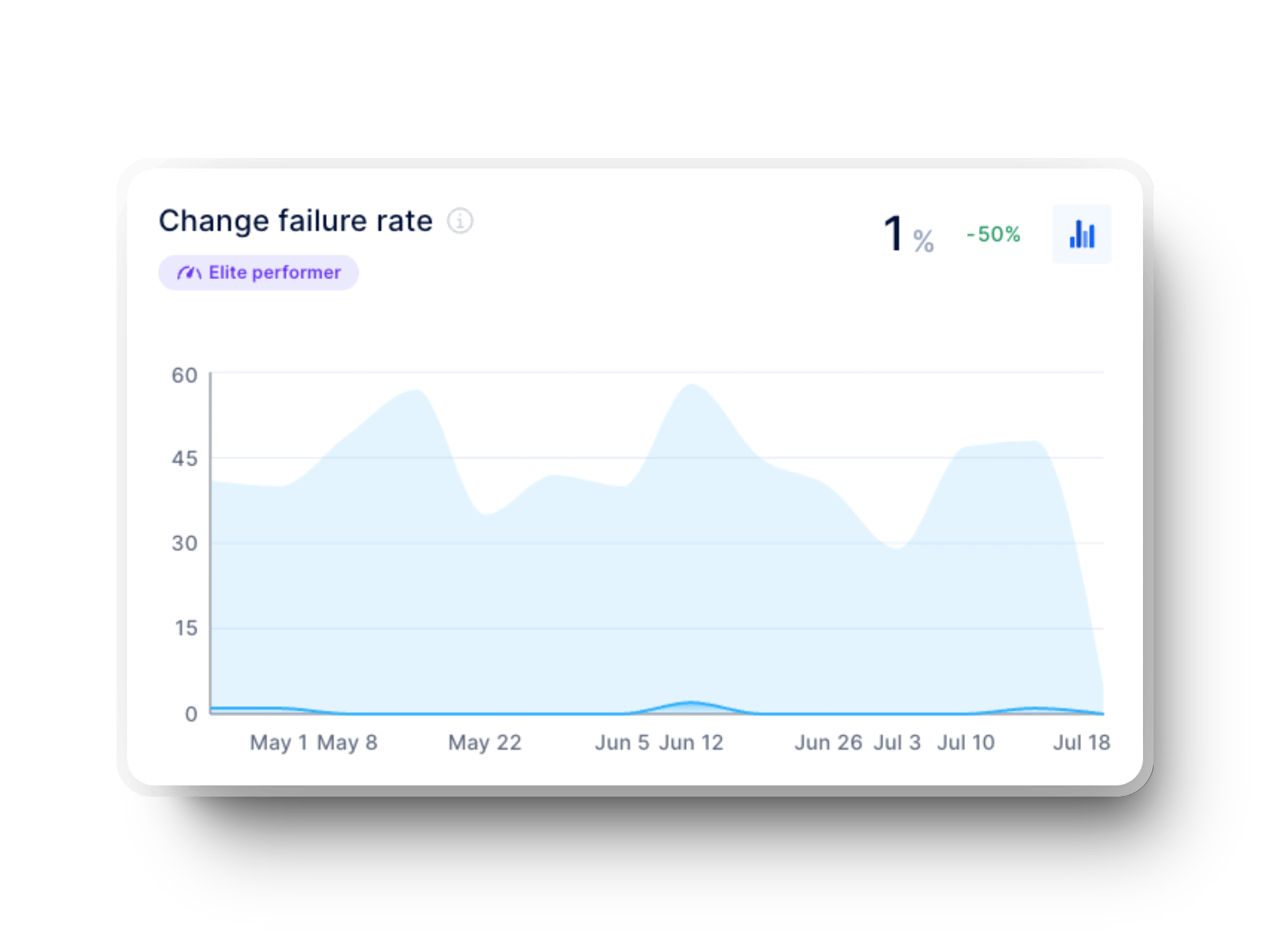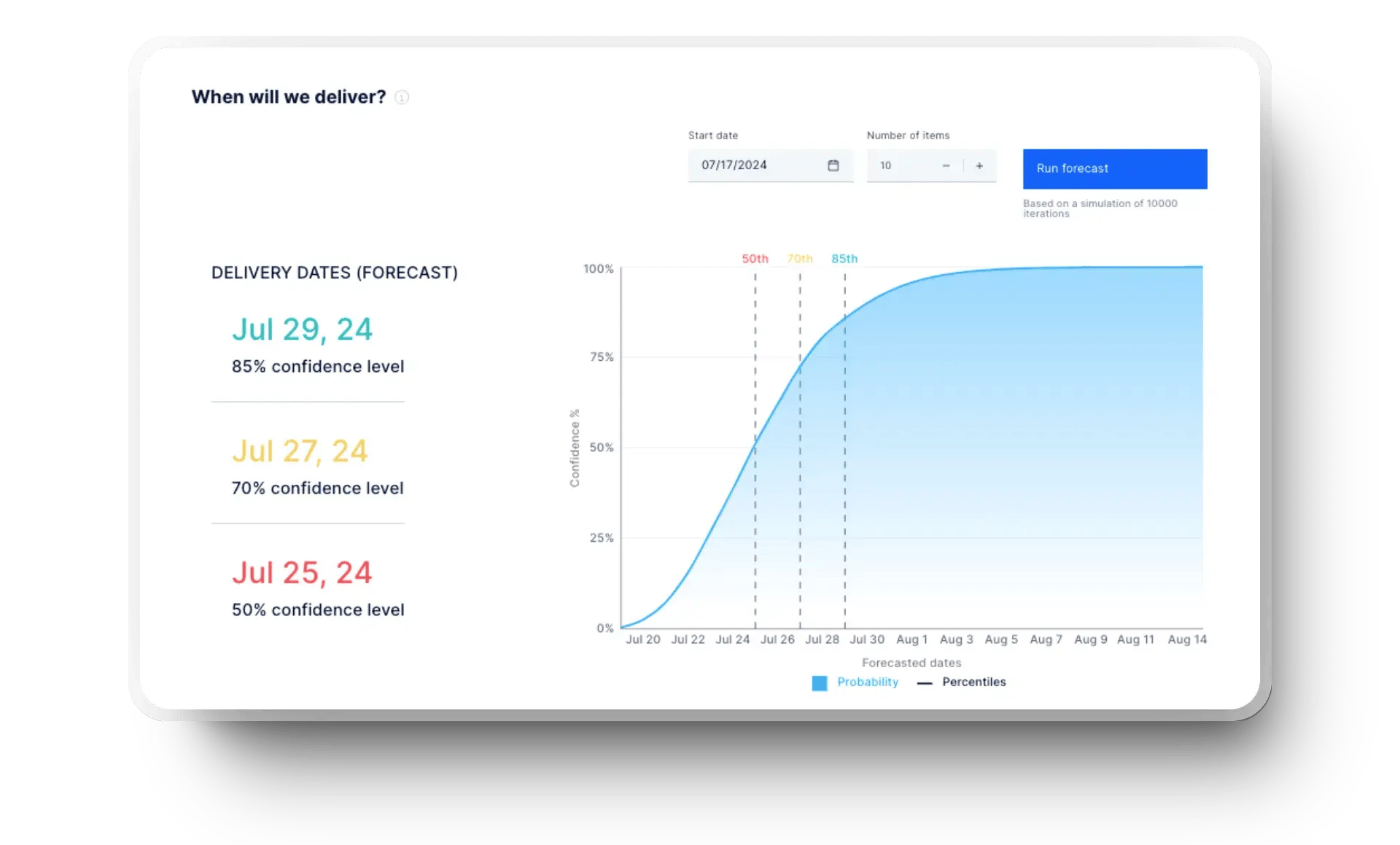Why do some engineering teams struggle with slow deployments, unpredictable releases, and constant firefighting while others ship high-quality software smoothly and efficiently?
The difference isn’t just skill; it’s how they use data to drive decisions.
A data-driven engineering approach helps them improve software quality by tracking key performance indicators, analyzing real-time trends, and using predictive insights.
Are you curious about how data can improve your engineering processes? This guide explains useful metrics, actionable steps, and how to build a data-driven culture across the SDLC.
So, let’s begin.
What Is Data-Driven Engineering?
Data-driven engineering is the practice of using key metrics and continuous feedback loops to get valuable insights. This helps you optimize software development even in complex systems.
Basically, engineering leaders need to make informed decisions based on data rather than intuition, which results in:
- Improved performance of systems
- Reduced failure rates
- Alignment with organizational goals
Data-Driven Vs. Traditional Engineering Approaches
There are some fundamental differences between traditional and data-driven engineering approaches, which we have outlined below:
1. Tracking Efficiency
Traditional teams measure efficiency anecdotally, which makes it hard to pinpoint what’s working and what’s not. Consider a manager saying, “It feels like we’re moving faster.” But how fast?
Data-driven engineering removes this guesswork by letting you monitor metrics like DORA, flow, and SPACE metrics (e.g., PR review time, handoffs, or coding time). These give you clear, objective data on workflow performance.
2. Problem Detection
In a traditional setup, bottlenecks become visible only when they become major issues, such as a last-minute deployment failure or a surge in bug reports.
Data-driven engineering flips the script using cycle time breakdowns, WIP, throughput, PR analytics, and more, to detect inefficiencies before they disrupt progress.
We encourage you to practice Value Stream Management to avoid bottlenecks and streamline your workflow.
3. Decision-Making
Leaders struggle to justify decisions in poorly understood traditional engineering cultures. In many such setups, there is no tangible proof to support their reasoning.
A data-driven approach, however, relies on clear numbers that make it easier to communicate value to executives.
4. Code Quality
In conventional workflows, code quality is evaluated after failures happen, usually based on customer complaints or outages. This slows down innovation and increases technical debt.
A data-driven engineering process prevents this by continuously tracking software quality metrics. These include change failure rates, bug frequency, rework metrics, etc. The point is to spot trends and defects and solve them. That way, you can maintain quality before release.
5. Performance Focus
Traditional performance metrics focus on individual productivity, such as the number of lines of code (LOC) a developer writes or the number of tasks they complete.
However, data-driven engineering shifts the focus to engineering productivity in the context of team effectiveness and collaboration. Instead of just rewarding output, you should continuously optimize system performance and overall team health.
However, you need to align your development efforts with business outcomes. Research shows that you can see 40% higher organizational performance if you prioritize user impact than those who don’t.
You also have to be smart about your tools. For example, using a public cloud increases infrastructure flexibility by 22%, which correlates with a 30% increase in organizational performance.
Tracking key engineering metrics is how you can move beyond individual output and drive sustainable productivity while improving overall business impact. That brings us to the next point.
Why Data-Driven Engineering Matters
Let’s dive into why data-driven engineering isn’t just useful; it's a game-changer:
1. Strategic Thinking and Stakeholder Alignment
With KPIs and accurate models, you can stay strategic with business goals and stakeholder expectations. Instead of making calls based on intuition, you can point to real data.
Say your team wants to upgrade its engineering infrastructure. Rather than pitching it as a "needed improvement" to executives, you can use a predictive model to prove how it boosts system performance and reduces failure rate to secure their buy-in.
2. Better Decision-Making
Data-driven engineering allows you to move beyond gut feelings and make decisions by using:
- Scientific methods
- Statistical modeling
- Machine learning techniques
- AI for developer productivity
Example: Code repositories sometimes accumulate inefficiencies that slow down development. Guesswork won’t reveal these bottlenecks, but analyzing code churn (how often code is rewritten), review time (delays in approvals), and process metrics (like cycle time) can pinpoint friction points. For instance, high code churn in specific files may signal unclear requirements or poor code quality, while long review times can indicate overloaded reviewers or inefficient workflows.
3. Faster Issue Resolution
Bottlenecks in coding, PR reviews, and deployment pipelines drag projects down. A data-centric approach cuts through this by exposing inefficiencies with process metrics focused on operational efficiency, like:
- DORA
- Cycle time breakdowns
- Code review time
- Issue type time investment
- Work in progress (WIP)
- And more
With these insights, you can tackle issues early to maintain low failure rates.
4. Optimized Resource Allocation
Without data, it’s common for your team to misallocate time, budget, or workforce on low-impact tasks. A data-driven approach addresses resource allocation by highlighting where your efforts deliver the most value.
For instance, if data shows your engineers spend excessive time on manual testing, shifting resources to automated testing frameworks can free them up for more complex problem-solving.
You can also use this Value Stream Mapping tool to identify bottlenecks and areas where automation—or other solutions—can make the most impact.

5. Increased Developer Efficiency
Developers thrive when they’re coding, not stuck in meetings or dealing with repetitive tasks that add zero value. With data-driven engineering, you can clear this clutter by automating low-impact work.
With features like cloud computing and AI techniques, your teams can spend less time on manual overhead, like reviewing logs, and more time solving real engineering problems.
According to McKinsey, software development has two main loops:
- Inner loop – Coding, building, and unit testing (the creative work).
- Outer loop – Integration, testing, releasing, and deployment (necessary but less engaging tasks).
Maximizing inner loop time increases productivity and developer satisfaction. Investing in better tooling and automation for the outer loop helps developers focus on building products rather than tedious processes.
Engineering Metrics That Matter
When it comes to data-driven engineering, there are a few metrics that really make a difference, including:
1. Leading Vs. Lagging Indicators
Waiting until something breaks isn’t a strategy. Traditional engineering relies on lagging indicators, like post-mortem incident reports, that highlight problems only after they happen.
Meanwhile, a data-driven approach focuses on leading metrics, which provide real-time feedback to prevent issues beforehand. Consider cycle time, deployment frequency, and flow efficiency: these foresee bottlenecks and risks instead of just analyzing past failures.
"Because leading indicators are a reliable (even if not so easy) way to check if the work done is actually generating impact to a startup’s goals. Without them we’d be in the dark about how meaningful people’s efforts (i.e., performance management) are. Also, we’d be lacking a valuable starting point for learning how to improve said efforts are over time."
2. Value-Focused Metrics
Frameworks like DORA and Flow bring in many valuable metrics for data-driven engineering, such as:
DORA Metrics
DORA (DevOps Research and Assessment) metrics help answer the question: "Is our deployment process efficient, or are we constantly firefighting?". They include:
- Deployment frequency: It tells how frequently your team ships code to a production environment. The more frequent, the better, as smaller releases reduce risk and make rollbacks easier.

- Lead time for changes: Tracking lead time for changes is the key to gaining insights into the time it takes for a change commit to go from development to production. Long lead times for changes usually signal bottlenecks in testing or inefficient CI/CD pipelines.

- Change failure rate: Change failure rates tell what percentage of changes cause issues. When it’s high, it means you need to figure out fixes for issues like poor validation processes, weak test coverage, or rushed releases.

- Failed deployment recovery time: Formerly known as mean time to recovery (MTTR), this metric tells how quickly your team responds to failures. Aim for low rates, as they indicate a strong incident response and a resilient system.
%20in%20axify%20for%20software%20development%20teams.webp?width=1920&height=1440&name=time%20to%20restore%20service%20(dora%20metrics)%20in%20axify%20for%20software%20development%20teams.webp)
Flow Metrics
Flow metrics are value-driven and tell how smoothly work moves through the pipeline. If deployments are slow, these metrics help you figure out why:
- Cycle time: It measures the duration required to complete a task from the start. Shorter cycle time indicates team efficiency, signalling faster development and fewer blockers.
- Throughput: With throughput, you know the number of features, bug fixes, and updates delivered in a specific period. When these numbers are low, it’s time to address underlying obstacles like a lack of resources or misaligned priorities.

- Work in progress (WIP): WIP refers to tasks or features actively being worked on but not yet completed. We recommend never letting too much WIP pile up, as it causes context switching and delays. A simple rule? Limit it to around your team’s size, plus or minus one.
%20in%20Axify.webp?width=1920&height=1440&name=work%20in%20progress%20(WIP)%20in%20Axify.webp)
- Flow efficiency: Compares active work time to total elapsed time. A low score suggests excessive idle time, which can be due to waiting on approvals, dependencies, or unclear priorities.
- Issue type time investment: This metric helps determine where the bulk of your team’s efforts are being spent, whether it’s on developing new features, fixing bugs, or handling ongoing maintenance. Understanding this balance helps prioritize tasks better and reduces technical debt.
How NOT to Use Data in Data-Driven Engineering
While we’ve explored the key metrics to track for data-driven engineering, it's equally important to understand some common pitfalls to avoid, like:

1. Not Focusing on The Biggest Impact
One of the biggest traps in data-driven engineering is working on changes that don’t make a real impact. Let’s say your automated tests run in 20 hours, and you get it down to 18. If your whole release process still drags due to a 46-day bottleneck in code reviews or infrastructure provisioning, that two-hour gain won’t matter.
Simply put, your focus should be on improvements that deliver a clear return and truly accelerate your delivery cycle.
2. Not Aligning Metrics with Business Goals
Metrics are only useful when they’re connected to your goals. Without that alignment, you risk pursuing the wrong priorities. For example, increasing deployment frequency might look like progress, but if those releases aren’t stable or don’t improve customer satisfaction, they’re not driving real value.
This means that every metric you track should guide efforts that directly align with your business objectives, whether improving reliability or enhancing user experience.
Axify helps you track objectives to measure your team's progress against corporate objectives.
![]()
3. Ignoring Context: Not Looking at Metrics Holistically
Zeroing in on one metric leads to bad decisions. For instance, your team’s PR review time drops, and it feels like a win as the code is moving faster to deployment. But if quality suffers, those gains come with more bugs and regressions.
The solution? As the SPACE framework advises, step back and use multiple metrics across multiple dimensions. We advise you to avoid trade-offs and ensure progress in one area doesn’t cause setbacks elsewhere. In this specific example above, you can also track metrics like change failure rate and post-release issues.
4. Over-Optimizing Everything
Trying to optimize everything at once?
Tracking too many KPIs is a surefire way to slow your team down. It can lead to endless tweaking instead of actually shipping software. Take software delivery, for example; overhauling it overnight may look impressive, but it’s virtually impossible. Small changes done consistently add more value than doing everything at once.
The smarter approach is to focus on metrics that genuinely drive business value and let the others take a backseat.
5. Using Metrics to Hold Individuals Accountable Instead of Focusing on Team Performance
When you rely on developer productivity metrics, such as PRs merged per week, to assess individuals, you create a fear-driven atmosphere instead of a growth-focused culture. For example, if developers know they’re being judged by the lines of code they write, they might produce bloated, inefficient code just to meet the target.
A better strategy is to shift the focus to team-wide trends and collaboration-driven metrics like DORA metrics, which give a big-picture view of engineering efficiency.
6. Using Metrics as an Excuse For Poor Management
Relying on metrics alone can lead to assumptions that miss the real issues. For example, high cycle time might seem like slow work by your team, but the cause could be unclear requirements or outdated tools.
The right way is to combine qualitative feedback from engineers with quantitative insights to uncover true bottlenecks.
How to Make Metrics Work for Your Team
The correct approach to using engineering metrics involves these steps:
- Think of metrics as helpful feedback tools, not rigid performance measures
- Look for patterns and trends instead of only examining individual numbers
- Focus on parameters that provide meaningful value and actionable insights
- Encourage teams to use data as a resource to guide their growth rather than a measure of external judgment
Data-Driven Engineering Across the SDLC
Data-driven engineering allows you to power your entire software development lifecycle with data and turn insights into action at every step. This is how:
1. Planning and Roadmapping
Teams that rely on gut instinct for sprint planning often miss deadlines and have overloaded engineers. Instead, they should use historical throughput data and cycle time trends to estimate sprint capacity based on actual performance, not arbitrary targets.
Insider tip: To streamline this, you can use tools like Axify’s software delivery forecasting, which leverages data and analysis of past trends to predict software delivery dates.
Furthermore, track task completion trends to prevent workload imbalances. And when planning features, prioritize customer feedback and recurring defect data. This way, you’ll ship features on time with higher impact and improved software quality while maintaining team well-being.
2. Development
In the development phase, you can reduce rework by monitoring change failure rates and rework trends, which help spot high-risk features and stories early. For example, if a feature constantly rolls back, it’s a sign of missing tests or unstable dependencies. Identifying these issues sooner leads to fewer late-night fixes and smoother deployments.
Data-driven engineering also helps pinpoint bottlenecks in PR cycle time, which leads to better collaboration. If reviews keep stalling, chances are reviewers are overloaded, feedback is unclear, or the process is too slow. You can fix these gaps to achieve faster merges and minimize frustration for everyone.
3. Code Review and Merging
Nothing slows down momentum like a dragging PR review process. When approvals take forever, it’s usually not just about the code; it’s unclear feedback or inefficient workflows that are getting in the way. You can track PR review time trends to spot what’s causing the holdup and fix it before it affects progress.
Then there’s the merge stage. If pull requests linger without getting merged, something’s off. It could be messy branching strategies, manual validation steps, or a lack of automation. Tracking merge times is the game-changer here, as it helps smooth out the process and keep updates flowing without compromising code quality.
4. Deployment and Release
Shipping code isn’t about getting it out the door; you must focus on delivering stable, high-quality updates without disruptions. Deployment frequency is a key metric for this as it can spot patterns in the release cycles, so updates go out consistently rather than in unpredictable bursts.
Assessing the lead time for changes is equally important. With this data-driven metric, you can quickly identify slowdowns in testing and approvals and fine-tune your CI/CD pipelines. Analyzing the change failure rate is also needed to identify weak points in validation or testing processes, which helps prevent unstable code from ever reaching production.
5. Monitoring and Post-Release Improvements
Gathering real-time incident data allows your teams to quickly detect issues and shorten recovery times after failed deployments. Moreover, tracking customer-reported bugs and performance regressions post-deployment provides valuable insight into customers' experiences. This lets you prioritize fixes that have the greatest impact on end-users.
Finally, looking at failed deployment trends over time allows you to identify recurring patterns. With this information, you can adjust release strategies, tighten validation processes, and ultimately ship more stable, high-quality updates.
5 Steps to Create a Data-Driven Engineering Culture
Wondering how to build a data-driven engineering culture? We have some clear steps to help you get there:
- Explain the need for change: Pull up historical data on deployment frequency, bottlenecks, and software inefficiencies to highlight where things slow down.
- Set clear, measurable goals: Prioritize outcomes over outputs, and let the DORA, Flow, and SPACE frameworks guide you in measuring software performance, efficiency, and team success.
- Use the right metrics: Focus on leading indicators like deployment frequency, lead time for changes, and technical debt ratio, which are the ones that reveal risks early to keep workflows smooth.
- Enable transparency and visibility: No one has time for digging through code repositories for insights. A real-time, integrated dashboard is the solution that gives engineers and leaders a clear view of key metrics.
- Promote a learning culture: Encourage your team to explore the data, identify patterns, and experiment with solutions. This approach turns mistakes into learning opportunities, leading to an innovative engineering process.
Common Mistakes in Becoming Data-Driven (And How to Overcome Them)
Using a data-driven approach in engineering comes with some challenges, but don’t worry, we’ve got practical fixes to tackle them:
- Data overload: Tracking everything at once leads to noise instead of clarity.
- Solution: Prioritize actionable KPIs like the ones we mentioned so far because they directly impact system performance and business decisions.
- Engineering resistance: Some teams see data tracking as micromanagement from leaders rather than support, which leads to pushback.
- Solution: Reframe key metrics as decision-making tools that enhance team performance. The focus should be on efficiency, not oversight.
- Lack of data literacy: Engineers may struggle to extract valuable insights from data without a solid grasp of KPIs.
- Solution: Train your teams in statistical modelling to interpret process metrics effectively. Focus on using predictive models and optimization algorithms to enhance decision-making.
- Siloed tools and scattered data: When code repositories and engineering systems are disconnected, teams struggle to get a unified view of metrics.
- Solution: Implement integrated dashboards like Axify to consolidate data from code repositories, code review processes, and software development workflows. This creates a single source of truth, which enables a data-centric approach.
How Axify Helps Engineering Teams Become More Data-Driven
Adopting a data-driven culture in your software workflow? Axify offers a range of features to help:
- Axify’s real-time engineering insights: Centralizes DORA and flow metrics in an intuitive dashboard.
- Value Stream Mapping (VSM): Pinpoints inefficiencies across the development pipeline.
- Daily Digest: Highlights high-risk items, streamlines your team’s discussions, and helps plan tasks around true priorities.
- Software delivery forecasting: Offers reliable estimates for software delivery based on historical data, so you always deliver on your deadlines.

Make data work for you. Begin your journey with Axify today by booking a demo!






.png?width=60&name=About%20Us%20-%20Axify%20(2).png)

.webp?width=800&name=Axify%20blogue%20header%20(8).webp)

